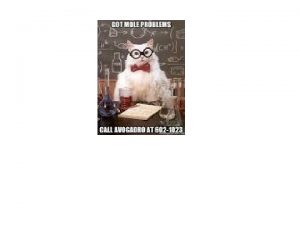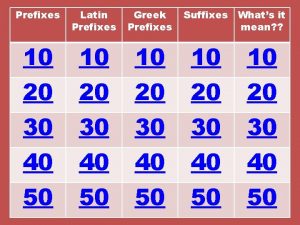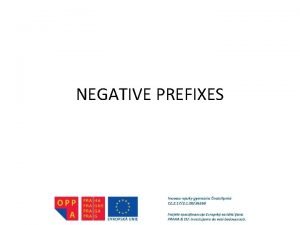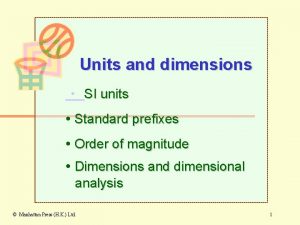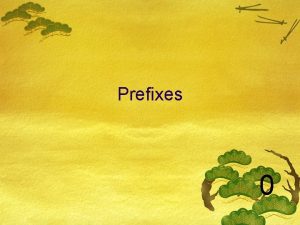SI UNITS THEIR PREFIXES WHY USE UNITS We










- Slides: 10

SI UNITS & THEIR PREFIXES

WHY USE UNITS? We know that in order for a measurement to make sense, it must include a number and a unit. For example, the following statements don’t make any sense without units: r: be m e R • Catherine walked one to the store to buy her favorite candy. (one mile, one minute? ) • Juan worked for three on his presentation for school. (three minutes, three hours? ) Adding units adds value and meaning to what we say: • Catherine walked one mile to the store to buy her favorite candy (she really wanted that candy!) • Juan worked for three hours on his presentation for school (that’s dedication!) A standard is an exact quantity that people agree to use in order to compare measurements

UNITS MUST BE STANDARDIZED Look at this situation: Scenario 1: An American woman is at an open market in Mexico. She finds a piece of pottery that she would really like to buy. Seller: “This is a beautiful bowl that could become a family heirloom. I’ll make you a good price. ” Woman: “Yes. Hmmm. I am interested, but it honestly depends on how much. ” Seller: “How about 15? Just 15 and it’s yours!” Woman: “Hmmm, ok 15 sounds good. ” She hands him a ten and five one dollar bills. The woman walks off with her purchase and the seller goes back to his tent with a giant grin on his face, calling over his shoulder, “Thank you!” << Why was the woman wondering why he was so happy? >>

UNITS MUST BE STANDARDIZED Just like in the skit, units in science must be standardized so that everyone can understand what is being said. We all must speak the same “measurement language” if we are to understand each other and work together. Which one can you better relate to? Four hands high Or… Four meters high 5. 5 bushels Or… 5. 5 kilograms 3 shakes of a lamb’s tail Or… 3 seconds

WHAT ARE SI UNITS? SI units are a set of seven units accepted and used by scientists all over the world. They are as follows: Quantity Measured Unit Symbol Length meter m Mass kilogram Kg Time second s Electric current ampere A Temperature Kelvin K Amount of Substance mol Intensity of Light candela cd So, if you want to measure a distance, for example, your unit used would be a meter. Or, if you wanted to measure the amount of electrical current in a circuit board, you would use amperes. Of course, people use units different than these all the time, but these are the seven universal units that any scientist around the world would know and be able to use.

METRIC PREFIXES So what if we need to report a length that is very short or very long? For example, it’s arduous to have to say 1, 000 meters. We would rather say and write one kilometer, 1 Km. We use PREFIXES The underlined letters are the symbol for that prefix hecto = h King Henry Died by Drinking Chocolate Milk

meter - m gram - g Liter - L Kilo - k hecto - h deca - da Are prefixes for things larger than a base unit (larger than one m, g, or L) They have number values that increase by powers of 10 10 1000 Are base units. These are starting points on the metric system and they have values of 100 (1) Really, any of the 7 SI units (m, Kg, s, A, K, mol, cd) could go in the blue box – we just use these three here because they are the most common ones. 103 102 deci - d centi - c milli - m Are prefixes for things smaller than a base unit (smaller than one m, g, or L) 101 They have number values that decrease by powers of 10 10 -1 10 -2 10 -3. 1 . 001

HOW TO USE THE PREFIXES 1. The prefixes can be placed in front of any of the SI units of measurement Ex: centisecond or millimole 2. Each prefix represents a specific power of ten Ex: kilo = 1000 (103) or deci =. 10 (10 -1) So, when you put a prefix on, you are literally stating a number to go with that unit Ex: kilogram means “thousand gram” and decimeter means “tenth meter” A bunch of bananas weighs about 2. 2 kilograms – two “thousand grams” A thimble of water weighs about 1 gram – no prefix on a base unit A typical pinky fingernail is about 1 cm across – one “hundredth meter”

NOW YOU TRY SOME • How else could I express ten grams? • 1 decagram • How many centimeters are in a meter? • 100 cm • What is the prefix symbol for a decagram? • dag • How many meters is one millimeter? • 1/1000 m or. 001 m • A kilometer is how many meters? • 1000 m • Challenge! How many hectometers is in one kilometer? • 10 hm

A SHORT REVIEW OF THE LAST TWO LESSONS:
 Why why why why
Why why why why Why does the us use customary units
Why does the us use customary units Mole problems
Mole problems Why architects need to use their ears
Why architects need to use their ears Prefixes for hydrates
Prefixes for hydrates When to use prefixes for naming compounds
When to use prefixes for naming compounds When to use prefixes for naming compounds
When to use prefixes for naming compounds Use your knowledge of prefixes and suffixes
Use your knowledge of prefixes and suffixes Dont ask why why why
Dont ask why why why Botox crow's feet injection sites
Botox crow's feet injection sites Variable costing income statement
Variable costing income statement


